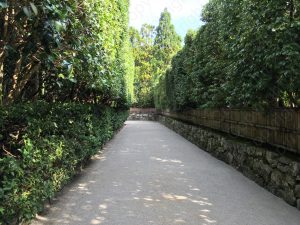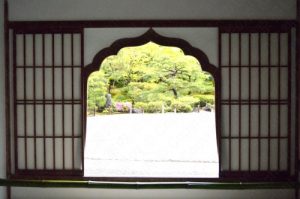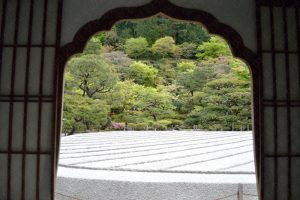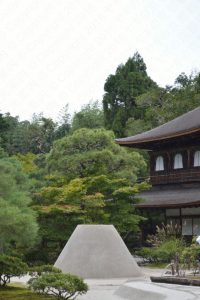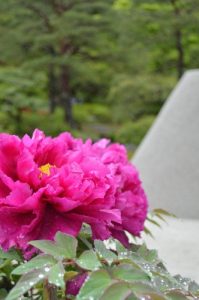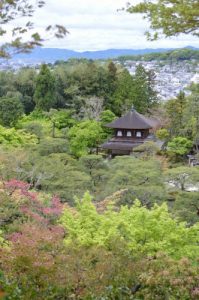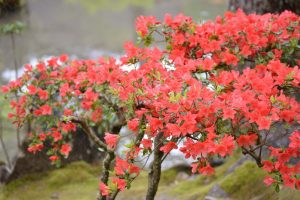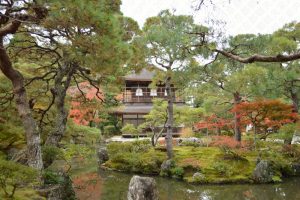Ginkakuji temple a.k.a. as the silver pavilion represents the origin of the Japanese cultural inheritance. Let us learn about what to see like dry garden, its history, and the way to access with precise map.
- What is Giknakuji (銀閣寺)?
- Ginkakuji temple and Higashiyama period/culture(東山文化)
- What to see in Ginkakuji temple?
- Flora of Ginkakuji temple
- Autumn colors in Ginkakuji temple
- Ginkakuji temple in snow
- Okuribi and Ginkakuji temple
- Special admission of Ginkakuji temple
- General information of Ginkakuji temple
- Access from Ginkakuji to Kinkakuji
- Access to Ginkakuji temple
What is Giknakuji (銀閣寺)?
Ginkakuji temple a.k.a. Jisyoji
Giknakuji’s formal name is “Tozan Jisyoji”. It is a sub-shrine of Shokokuji and was built by Ashikaga Yoshimasa, the 8th shogun of Ashikaga Shogunate, in the 15th century as his retirement villa named Higashiyama-sanso. After his death, it is named “Jisyoin” after his Buddhist name and became a Buddhist temple of Rinzai school. Ginkakuji and the garden adjacent to it represent so called “Higashiyama period/culture” and was listed as a World Heritage site in 1994.
Why is Jisyoji called “Ginkakuji” temple, the silver pavilion?
Ginkakuji never seems to be “Silver” though Kinkakuji glitters gold. (“Gin” means silver and “Kin” means gold in Japanese.)There were some disputes on the issue. Some says Gikukakuji was plastered with silver actually and some says financial problems prevented Yoshimasa from plastering it with silver. In 2007, an investigation team x-rayed the surface of the pavilion only to found no trace of silver on it. There are many hypothesis on the matter but the reason remains secret.
Ginkakuji temple and Higashiyama period/culture(東山文化)
Higashiyama period/culture was established as a fusion of cultures of court nobles, samurai-warriors and Buddhists who learned the Buddhism overseas. Before the period, aristocrats and court nobles cultivated most of Japanese culture. For example, The Tale of Genji was written by a lady who served imperial court. Samurai-warriors had special interests in the Buddhism, mostly Zen. You might think Zen is not suitable for war-time philosophy. Samurai lead a highly disciplined life and Zen was accomplished through daily life. Zen was fascinating for them as a code of Samurai. Buddhists studied in China and brought the Chinese latest culture.
The fusion of these three cultures made a foundation of traditional Japanese culture we know today. Tea-ceremony, Noh, Kado (Japanese flower arrangement), dry garden, and so on. For example, the rock garden in Ryoanji temple was built in the period.
In the period, infamous Onin-no-ran, the largest civil war in the middle ages of Japan occurred. Many people escaped from Kyoto to the provinces. Thanks to them, the cultures born in Kyoto spread all over the archipelago.
What to see in Ginkakuji temple?
Ginkakuji-gaki
An approach of Ginkakuji. It leads visitors into the Nirvana which Ashikaga Yoshimasa wanted to find in Higashi yama sanso.
A dry garden in front of Kuri
Kuri is a residence for monks (the house in the pictures above). The dry garden gives us modern impression because it has nearly symmetric construction.
Kannnon-den a.k.a. Ginkakuji(National treasure)
So called “Ginkakuji”/ The silver pavilion. The formal name of the pavilion is “Kannon-den”. As I indicated before, NO silver was plastered. People did not call Konnon-den the silver pavilion before the 17th century. Kannon-den is a two storied pavilion. The first floor is “Shin-ku-den (心空殿)” which has a construction resembles residence. Shin-ku-den means “The hall where we can have emptied mind”. Ashikaga Yoshimasa used to meditate there. On this floor, Kannon statue was enshrined. Kannon is the Buddhist Goddess who saves people with her mercy. The second floor is “Kaion-kak (潮音閣)”, which has a Zen-fashioned floor. We are not allowed to enter the pavilion.
At the top of the roof, there is a statue of “Ho-oh (鳳凰)” as a guardian of Kannon inside of the pavilion.
As the founder, Ashikaga Yoshimasa, intended, we can see the pavilion anywhere in the temple grounds.
Gin-syadan (銀沙灘)
The dry garden in front of Kannon-den. It stands for ripples on the sand sea. The white sand contains large quantity of quartz for the purpose of reflecting sunlight. Traditional Japanese residence does not distinguish the inside and out side of the house precisely. Dry garden often plays a role as lighting to reflect the sunlight and moonlight. In the night time, I suppose the quartz in the sand reflects moonlight and Kannon-den glimmers “Silver”. I believe that is the reason why we called Kannnon-den “the silver pavilion”.
Ginsyadan from the window
This window has “Shoji” at the both side of it. We can adjust the side of a frame of the window and enjoy many views of Ginsyadan through it. That is the way to admire the garden in the days of old.
Kogetsu-dai (向月台)
The mountain-like object in front of Kannon-den. No one knows what it is. Some says it is a platform to see the moon.
Togu-do 東求堂 (National treasure)
It was made as a “Jibutsudo” of Ashikaga Yoshimasa’s. Jibutsudo is a building to enshrine Buddhist statues and pray. The room called “Dojinsai” is the origin of a traditional Japanese tea room. Dojinsai is an excerpt of a verse composed by Han yu, the poet in Tang dynasty. The excerpt means “The great person respects equality.”.
Togu-do worked as “Kaisyo”. Kaiyo means a place in which people gather for cultural enjoyment like verse-composing, Japanese flower arrangements and tea-ceremony. We can not enter Togu-go except special occasion.
Ginkakuji-gata-tyozubachi 銀閣寺形手水鉢
It is a wash basin. It represents a garment monks wear. It is located between main hall and Togu-do. The small dry garden was built in Edo period.
The garden
The garden was build on the construction of that of Saiho-ji. Ashikaga Yoshimasa has a special interest in Saiho-ji temple as a composer of garden.(To “compose” garden may sound strange but I believe traditional Japanese garden is a thing to “compose”.)
Kinkyo-chi pond 錦鏡池
The pond spread in front of Kannnon-den and Togu-do.
Moss
Ginkakuji is rich in moss. You would love to see it.
Sengetsusen 洗月泉
In night time, a reflection of the moon is on the surface of the water. Ripples swing the reflention with gentle caress. That movement look like as if ripples were washing the moon. So this well is named Semgetsusen, the well to wash the moon.
Tsukimachi-yama 月待山
The well for tea ceremony お茶の井
It is a debris of the oringinal garden. From the well, Ashikaga yoshimasa drew water for tea ceremony.
Observation place 展望台
We can have a good view of mountains and Kannon-do.
Flora of Ginkakuji temple
In Ginkakuji, we have many plants and flowers. Of course we can see them other places. The distinctive feature in Ginkakuji is there aren’t many flowers and are many green leaves and mosses instead. Thanks to this, we can see flowers against the green.
Autumn colors in Ginkakuji temple
Maple leaves in Ginkakuji was deliberately and exquisitely planted to go with the green leaves.
If you were interested in Autumn leaves in kyoto, see the video above.
Ginkakuji temple in snow
Ginkakuji in snow takes your breath away. We have only 1 or 2 snowing days in a year. If you are in snowing days, you better rush to Ginkakuji.
STRONGLY RECOMMENDED!!!!!!
Okuribi and Ginkakuji temple
The mountain behind Ginkakuji, we have bonfire called “Okuribi”. In the mid August, we believe our ancestors who passed away come back to us and stay with us in short period of time. When they go back where they belong, we wave our good-bye with Okuribi.
The bonfire tells Kyotoite summer was nealy ending.
Special admission of Ginkakuji temple
We can enter the main hall and Togu-do. It take place on one time an hour basis. The picture above was taken in 2016.
The time table of this year is different. See Shokokuji web site. (Japanese only)
General information of Ginkakuji temple
Tozan Jisyoji
Address 2 ginkakuji teramahi, sakyo-ku, kyoto 〒606-8402
Phone +81 075-771-5725
FAX +81 075-771-5439
Website
Shokokuji web site (In side of Shokokji site, there is a Ginkakuji site.)
Opening hours
March~November 8:30~17:00
December~Feburary 9:00~16:30
Admission fee Adult and high school student 500yen
Access from Ginkakuji to Kinkakuji
From Kinkakuji to Ginkakuji, we have many buses to take. We take no.204 bus. No.204 is a loop line. We have clockwise no. 204 and anticlockwise no. 204. We take clockwise 204 because it is less crowded. Go to the bus stop (Ginkakuji michi bus stop) indicated in the map shown above.
Get off the bus at Kiknkakuji michi bus stop.
Access to Ginkakuji temple
From JR Kyoto station
At A2 in the bus terminal, take bus no.17.
Get off at Ginkakuji michi bus stop. On getting off, turn right and walk toward the mountains.
From Gion shijo sta. and Kawaramachi sta.
At Shijo kawara-machi bus stop, take bus no.17.
Get off at Ginkakuji michi bus stop. On getting off, turn right and walk toward the mountains.





